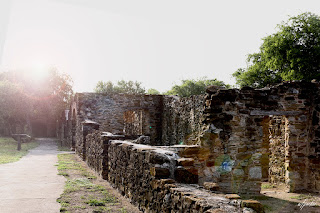I've been meaning to get back to finish what I started in October 2015 at the San Antonio Missions and I finally got around to it a couple of weeks ago. Cathie was going down to house/dog/cat-sit at Ellen's & Stan's and when she mentioned it, I thought I could go down too and finish taking my pictures. I'm still learning the intricacies of my Canon after two years, so when results showed I needed to go back to factory default settings and set it up again, it took a while to figure out just how to salvage a reasonable number of images from the shoot. So I'm set up again and I spent a couple of days Photoshopping some of the better images into submission. I hope you like them.
Unfamiliar with specifics of the San Antonio rush hour traffic, I left Ellen's shortly after sunrise and headed south on surface streets to get through the center of town to what I think of as the Mission District. I made it eventually to Mission Conception (above and below). The GPS helped, but the number of city streets under repair, maintenance on other city infrastructure, and detours associated to all of them kept me aware of where I was but helped me only marginally to figure out how to get to my destinations. That said, I got a few satisfactory shots of Mission Conception in the early morning.
The 200+ year old mission architecture is the primary draw for me at all these sites. However, they're not all created equal and Conception uses some very effective landscaping to accentuate its particular highlights. I'd like to see some park benches set out in shaded areas of the church grounds here - some like to wander around, and some like to take advantage of quiet time, contemplating the years when these places were daily bustling with life.
Compare this shot (above) with this one (image 1) taken at Mission Espada in 2015. I started at Espada that morning and this morning I arrived after shooting at Conception. I assumed when I first glanced at this image that the orange morning light had dissolved as the sun climbed, but looking at the recent group of shots I took at Espada, now I think I may simply have botched my camera settings.
Compare the sun positions in image 1 and 4; not too different and taken just over 30 min apart. After looking at this batch (overexposed originally), it's hard to imagine the impression the orange light and clear blue skies made on me in that first shot taken nearly two years ago. Orange or no orange, I like both shots above, but I have no doubt I'd like them better if I'd been able to reset the camera on the spot. Having to do it at my desk with the User's Manual (.pdf) open on my desktop and no time constraints just provides a reminder that I need to get out and shoot more often - and regularly wouldn't be amiss.
Ah, on to my favorite, Mission San José y San Miguel de Aguayo.I followed the same basic route around the mission as I had on my first trip in '15. But it was a lot hotter in August than it had been that October, and I was two years older. I admit I was flagging a bit and taking advantage of the park benches provided here. So, with less walking and more time on the benches I was able to pay closer attention to details than I had before and kept shooting pictures while resting.
Being always mindful of the possibility I could collapse on one of these treks and the temperature difference between the shade and the open courtyard, I bring along a small, folding garden bench. Shooting from the benches also adds some variety to the point of view - everything isn't necessarily shot from 6 ft above ground - and I like the perspective in this shot along the passageway of the convento.
This one and the previous image are both pointing at the same spot, this one just taken from the courtyard toward the end of the passageway. I was resting on one of the park benches, shooting shapes, shadows, and shrubbery - some potted, some otherwise. This probably my favorite shot of the day.
I was standing for this one - and in the sun. The courtyard, which encompasses the church and convento is more than a stone wall. The structure reminds me of 1940's and '50s motels you'd see across the southwest as you raced by on Route 66. The 4th picture (above) gives you an idea of the typical structural dimensions of what the monks would undoubtedly have referred to as "cells". The picture above shows a cell door and window near the end of the long enclosure and this image (picture 6) from 2015 shows a series of cell doors and windows on the right hand side, as well as a large gate through which horses and wagons would have accessed the courtyard. The arch (above) marks a smaller gateway between the courtyard and utility area outside, the mission's mill and acequia (picture 6).







